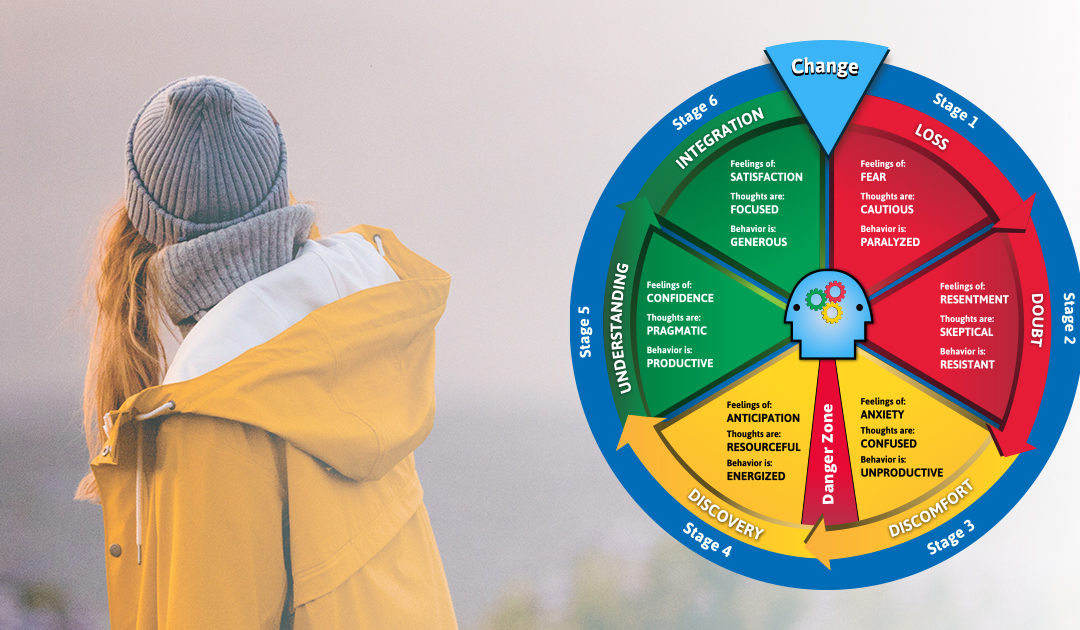Change is part of life, and it’s a huge part of travel, but that doesn’t mean we’re always prepared for it.
Even if you know to expect the unexpected, you also need to know how to deal with change in a healthy and productive manner. Everyone has their own way of processing change, but one useful tool is the Change Cycle model, developed by business executives and psychologists to be universally useful and easy to understand.
When traveling with a student group, change comes in all shapes and sizes. This entire cycle can happen in a matter of minutes for small changes, such as a theme park ride breaking down. You experience a moment of disappointment, then hopefully assess the situation, find another ride to enjoy and move on.
In the case of a large change like a global pandemic, it may take months or even years to fully experience the Change Cycle. If you know how the cycle works, however, you can move on to understanding and integrating the change into your life.
STAGE ONE: LOSS
Immediately after the change happens, everything comes to a halt. The unexpected has arrived, a loss has occurred, and our mind’s first reflex is to feel fearful, cautious, maybe even paralyzed. Before you can move on, you need to take a moment to find personal safety and regain some sense of control.
This means asking a few key questions and answering honestly: What are your specific concerns over this change? What’s the worst that can happen? And most importantly, what’s most likely to happen? It’s not a pleasant situation to be in, but instead of letting anxiety take control, you need to be realistic.
Example: You had a dinner reservation for your group, but the restaurant has a simple sign on its door: Closed for an emergency. Now what?
STAGE TWO: DOUBT
Doubt is your brain trying to slow down and be cautious before moving forward.
There’s nothing wrong with that—being cautious in the face of change is likely wise. But this doubt can also manifest in nothing but anger, as you’re feeling stubborn, resentful of the loss, and resistant to reality. You’re trying to claw back the past, living in a state of denial.
This can result in blaming others or immediately fighting to prove your way is right. You can’t see reality for what it is, because you don’t want to! The solution is to gather accurate information and get a clear picture of the situation you find yourself in.
Example: You check your email to make sure you actually had a reservation. You check the restaurant’s social media for more information.
STAGE THREE: DISCOMFORT
Now we’ve moved onto the yellow stage, we’re feeling cautious, but not quite ready to move forward. Change is uncomfortable, especially once we’ve acknowledged it as fact. You have a clear picture of reality, but now there’s all this new information to process. You may feel overwhelmed with anxiety and confusion, just wanting to give up.
This is a pivotal moment. You can either move forward to stage four, or enter the Danger Zone, in which your anxiety turns to real fear and you find yourself back at stage one. To move through, don’t think about the distant future—focus on the present and do whatever it takes to motivate yourself to take the next best steps.
With student travel, you have the advantage of collaboration—tour operators, fellow educators, even your students can all be of assistance. Work together!
Example: You rally with the other leaders on the trip. You start discussion your options and gather their opinions.
STAGE FOUR: DISCOVERY
You see the light at the end of the tunnel, but it’s not time to rest on your laurels just yet. Progress has been made, resulting in feelings of anticipation, resourceful thoughts and energized behavior.
You may not love the change, but at least you’re ready to take control.
Having gathered as much information as possible, you have perspective and insight into the change situation—now it’s time to create options and prepare decisions. The challenge here is to pick your path and take it, moving beyond reflection and into action. When you’re in a leadership position, people are counting on you to make this happen.
Example: You’ve called around and now have a couple options with various pros and cons. You weigh your options and make a decision.
STAGE FIVE: UNDERSTANDING
Now you’re in a good place, feeling confident, competent, and thinking pragmatically.
You don’t have to be happy at this stage. You don’t have to gladly “accept” the change, or like that it happened at all. But you’re ready to move beyond it, and that’s what matters. There may be lingering frustration, disappointment, even hesitance, but you understand the change has happened and that it’s time to move on for now.
Example: This is the, “Alright everyone. Let’s move out,” moment. No one’s happy with the inconvenience, but you’re making moves.
STAGE SIX: INTEGRATION
Welcome to the “new normal,” a phrase that perfectly captures this cycle: We may not like the change, but we’ve decided to live with it. It is now a part of our lives, integrated into our reality.
You’ve seen the change’s past, present and future implications. You feel satisfied to be beyond the fear, and even generous with your behavior—willing to help others move past the danger zone.
For leaders, this is when you’re ready to help comfort the team, such as students who have a hard time getting over the disappointment of change. They may still be in stage two, looking for a way to bend the reality of the situation to their will. You’ve been through this already—walk them through it.
The important thing now is to avoid becoming complacent or arrogant. You can hope that more change doesn’t happen, but it will. Use this opportunity to prepare for the next change. Much like exercising a muscle, moving consistently into stage six makes you more resilient and flexible for future changes. It’s okay: You’ve done this before.
Example: You’re back on the bus, headed to the new restaurant. Take time to get the students excited for the change of plans, and reassure them that no matter what happens, you’ll all make the most of it.
This article was written by Managing Editor Josh Veal for Teach & Travel.

